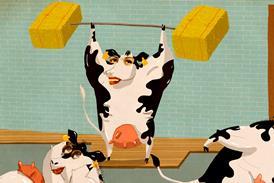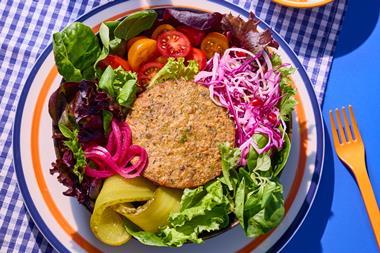Rising interest rates and escalating commodity prices are expected to prompt major changes in supermarket ranges, according to grocery buyers, but in most cases, not just yet.
This summer's deluge, which has devastated pea, broccoli, cabbage and lettuce crops, is just the latest in a series of events to affect grocery prices.
Recent hikes in interest rates have started to hit home too and costs of grain, wheat, milk, oils and tea have soared. At the same time, world markets are being stimulated by economic and population growth in India and China, so demand has increased. Add in an Australian drought, poor 2006 harvests in the northern hemisphere and a US drive for biofuels and you have a recipe for rising prices.
Food inflation is already 4.8% and soaring ahead of official overall inflation. This trend is expected to continue, especially for seasonal products.
There's no doubt that trading conditions on both sides of the buying line are tough, with challenges ahead for retailers and suppliers.
“The effects are going to roll out gradually,” says one buyer. “Fresh sectors, particularly those that source their produce from the flood-affected areas of this country, will feel it first, followed by the likes of ready meals, canned, dairy and bakery, but it will be a while before consumers see the effects on other shelves.”
Most of our panel agree that the effects will not bite fully for a while. Indeed, even one fresh meat and poultry buyer says the only pressure on pricing that he's experiencing so far is increased feed prices.
“Rising interest rates and commodity prices aren't affecting the market yet but I can see they're going to,” adds a buyer in the confectionery market.
“We've got everything covered for the next 12 months but after that milk and wheat prices especially are going to take their toll.”
While some areas are fairly calm, the situation is more acute for others, with dairy buyers already feeling the pinch.
“Manufacturers are starting to think about switching their milk from cheese to products with better margins, such as butter,” says one. “There are long-term contracts in Cheddar, which has meant the price increases aren't being seen so much there yet, but they are coming.”
The longer-term prospects are forcing many buyers to rethink their sourcing. “We either have to look for alternative suppliers from other markets or look at raising prices,” says one.
Others are starting to source products that have higher price points and higher margins, although not necessarily premium lines.
“The current climate is affecting the way we source products and we are looking at higher-value products. We'll obviously still carry the standard lines but we're looking at different areas. This is not just because of rising prices though - it's the general trend across the market,” says one buyer.
Adding value will be key, says another buyer. “The market is already moving towards higher-value sectors,” he says. “Consumers will always want the standard products but they will pay more for something extra.
“We're looking at functional lines rather than premium. The success of functional yoghurt drinks has already shown what can be done here.”
However, offering consumers extra value to encourage them to spend more will not absorb all the potential price rises.
With the major multiples trying to mitigate pressure on their profit margins, there are tough negotiations ahead and some buyers admit that suppliers are likely to be squeezed further.
“There's no doubt that manufacturers will be asked to help carry the costs,” admits one buyer. “Consumers will accept small price increases but we'll still be looking for discounts and promotional support.”
Another agrees, saying: “Obviously, we want to retain our margins, so we're encouraging our suppliers to work with us to minimise the effects for consumers.”
As far as sales of products that rely on the commodities most affected by rising prices are concerned, buyers generally seem sanguine about their category's long-term prospects.
“It is possible that there may be some short-term drops if prices rise steeply,” says one. “But once they settle, consumers will return to the affected products.
“I don't think it will affect sales of products that are made with the commodities concerned. At the moment, consumers will cope with small increases - 5% seems to be the feedback - but if it ever got to 20% or 30%, I'm not sure.”
However, rising prices are likely to be advantageous for some categories. “We need a bit of inflation in confectionery,” says one buyer.
“It's been flat for the past few years and people are now buying less as awareness of obesity grows slowly but surely.”
Others are determined to see the positive potential of the pressures ahead, with one buyer saying: “We can't allow this to affect how we trade. In this job, you can't see anything as a problem. You always have to look at it as an opportunity.”
1) Are rising interest rates and commodity prices affecting the type of products you are sourcing?
Yes 90%
No 10%
2) Are you changing your ranges as a result of high interest rates and commodity prices?
Yes 80%
No 20%
3) Will you be sourcing more premium products as a result?
Yes 60%
No 40%
4) How concerned are you about rising commodity prices?
A lot 40%
A little 60%
5) Are they likely to affect sales of products that contain these commodities?
Yes 50%
No 20%
Don't know 30%
Source: Telephone poll conducted by The Grocer
This summer's deluge, which has devastated pea, broccoli, cabbage and lettuce crops, is just the latest in a series of events to affect grocery prices.
Recent hikes in interest rates have started to hit home too and costs of grain, wheat, milk, oils and tea have soared. At the same time, world markets are being stimulated by economic and population growth in India and China, so demand has increased. Add in an Australian drought, poor 2006 harvests in the northern hemisphere and a US drive for biofuels and you have a recipe for rising prices.
Food inflation is already 4.8% and soaring ahead of official overall inflation. This trend is expected to continue, especially for seasonal products.
There's no doubt that trading conditions on both sides of the buying line are tough, with challenges ahead for retailers and suppliers.
“The effects are going to roll out gradually,” says one buyer. “Fresh sectors, particularly those that source their produce from the flood-affected areas of this country, will feel it first, followed by the likes of ready meals, canned, dairy and bakery, but it will be a while before consumers see the effects on other shelves.”
Most of our panel agree that the effects will not bite fully for a while. Indeed, even one fresh meat and poultry buyer says the only pressure on pricing that he's experiencing so far is increased feed prices.
“Rising interest rates and commodity prices aren't affecting the market yet but I can see they're going to,” adds a buyer in the confectionery market.
“We've got everything covered for the next 12 months but after that milk and wheat prices especially are going to take their toll.”
While some areas are fairly calm, the situation is more acute for others, with dairy buyers already feeling the pinch.
“Manufacturers are starting to think about switching their milk from cheese to products with better margins, such as butter,” says one. “There are long-term contracts in Cheddar, which has meant the price increases aren't being seen so much there yet, but they are coming.”
The longer-term prospects are forcing many buyers to rethink their sourcing. “We either have to look for alternative suppliers from other markets or look at raising prices,” says one.
Others are starting to source products that have higher price points and higher margins, although not necessarily premium lines.
“The current climate is affecting the way we source products and we are looking at higher-value products. We'll obviously still carry the standard lines but we're looking at different areas. This is not just because of rising prices though - it's the general trend across the market,” says one buyer.
Adding value will be key, says another buyer. “The market is already moving towards higher-value sectors,” he says. “Consumers will always want the standard products but they will pay more for something extra.
“We're looking at functional lines rather than premium. The success of functional yoghurt drinks has already shown what can be done here.”
However, offering consumers extra value to encourage them to spend more will not absorb all the potential price rises.
With the major multiples trying to mitigate pressure on their profit margins, there are tough negotiations ahead and some buyers admit that suppliers are likely to be squeezed further.
“There's no doubt that manufacturers will be asked to help carry the costs,” admits one buyer. “Consumers will accept small price increases but we'll still be looking for discounts and promotional support.”
Another agrees, saying: “Obviously, we want to retain our margins, so we're encouraging our suppliers to work with us to minimise the effects for consumers.”
As far as sales of products that rely on the commodities most affected by rising prices are concerned, buyers generally seem sanguine about their category's long-term prospects.
“It is possible that there may be some short-term drops if prices rise steeply,” says one. “But once they settle, consumers will return to the affected products.
“I don't think it will affect sales of products that are made with the commodities concerned. At the moment, consumers will cope with small increases - 5% seems to be the feedback - but if it ever got to 20% or 30%, I'm not sure.”
However, rising prices are likely to be advantageous for some categories. “We need a bit of inflation in confectionery,” says one buyer.
“It's been flat for the past few years and people are now buying less as awareness of obesity grows slowly but surely.”
Others are determined to see the positive potential of the pressures ahead, with one buyer saying: “We can't allow this to affect how we trade. In this job, you can't see anything as a problem. You always have to look at it as an opportunity.”
1) Are rising interest rates and commodity prices affecting the type of products you are sourcing?
Yes 90%
No 10%
2) Are you changing your ranges as a result of high interest rates and commodity prices?
Yes 80%
No 20%
3) Will you be sourcing more premium products as a result?
Yes 60%
No 40%
4) How concerned are you about rising commodity prices?
A lot 40%
A little 60%
5) Are they likely to affect sales of products that contain these commodities?
Yes 50%
No 20%
Don't know 30%
Source: Telephone poll conducted by The Grocer














No comments yet